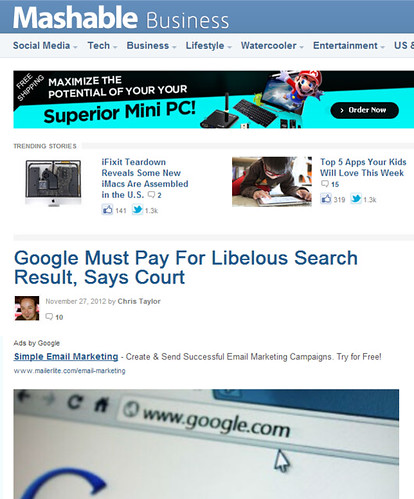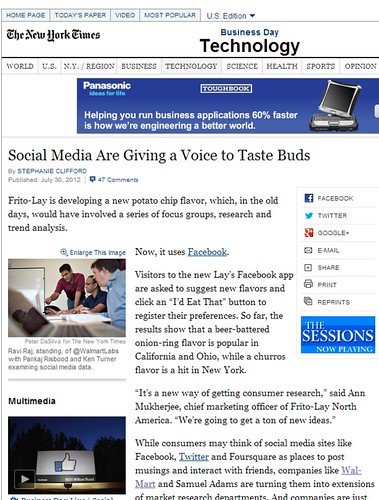 News on Social Marketing, according to Jeffbullas.com : interacting with image capturing machines, like the still and video cameras, is just part of the human evolutionary process.
News on Social Marketing, according to Jeffbullas.com : interacting with image capturing machines, like the still and video cameras, is just part of the human evolutionary process.
Comparing today’s digital cameras, video production and photo processing in the past has a much more complicated process. To get those images back, you have to wait for days as these films had to be taken to the local photo lab for processing or films were over exposed or blurred because of the camera didn’t work.
Today, digital cameras are fixed in every smartphone and include high definition capabilities that display every important detail. Security cameras that records crimes and crowds are also available to help identify unsuspecting criminals.
With a couple of clicks, you can easily take photos and videos and share them on Facebook, Pinterest or Twitter. This brings visual imagery to a new level in the social web.
Over the past 2 years, an increase of 800% was recorded on search volumes for the term “Infographics” on Google. Social media networks of Pinterest and Instagram have also exploded into mainstream consciousness. Google+ was launched with a highly visual user interface that displayed images in large sizes with HD capabilities. Facebook’s timeline format followed very quickly afterwards.
For the last 24 months, web design has changed considerably, with video and photos figuring significantly. For consumers to see the quality and textures of a product, online stores use the zoom features to display them.
It is important to include images in your marketing to draw out emotion and also in driving social sharing. Platforms such as Google+ and Facebook have seen an increase on engagement with the power of images.
Read more at How to Tap Into The Marketing Power of the Visual Social Web – Infographic
 News on Google Marketing, according to Mashable : Google is appealing the ruling of a high court in Australia saying that Google search results amount to content that the company “publishes” and is responsible for.
News on Google Marketing, according to Mashable : Google is appealing the ruling of a high court in Australia saying that Google search results amount to content that the company “publishes” and is responsible for.
The decision of the Australian court will force Google to pay $200,000 in damages to music promoter Milorad Trkulja. Milorad Trkulja, the plaintiff, brought the suit in 2009 after Google refused to remove links to sites that claimed, incorrectly, that the promoter has connections to organized crime in Melbourne.
Google explained that it is not a publisher and its search algorithm points to the most likely links; no persons were involved in the presentation of your results. A company spokesperson wrote after the result, “The sites in Google’s search results are controlled by those sites’ webmasters, not by Google.” This stance by Google has been approved by other courtrooms around the world and has a lot of technological sense to it.
Jury at the Supreme Court of Victoria agreed with Google up to a point that it is not responsible for the results until Trkulja asked it to take them down.
With the result, Google will be forced to follow every takedown notice it receives from an Australian citizen, although it would not make Google responsible for the entire web’s content.
Read more at Google Must Pay For Libelous Search Result, Says Court
 News on Social Marketing, according to The New York Times: Frito-Lay North America has found a new method to get a consumer research on their new flavors. Visitors to the new Lay’s Facebook app, Lay’s Do Us a Flavor app, are asked to suggest new flavors and click an “I’d Eat That” button to register their preferences.
News on Social Marketing, according to The New York Times: Frito-Lay North America has found a new method to get a consumer research on their new flavors. Visitors to the new Lay’s Facebook app, Lay’s Do Us a Flavor app, are asked to suggest new flavors and click an “I’d Eat That” button to register their preferences.
Frito-Lay can tailor its products to specific areas of the country once the company sees what is popular and where. While Frito-Lay will produce three of the flavors from its contest and give a $1 million prize to the creator of one of those flavors, the company would also study other suggestions.
Ann Mukherjee, chief marketing officer of Frito-Lay North America said that, “It’s a new way of getting consumer research and we’re going to get a ton of new ideas.”
Social media sites like Facebook, Twitter and Foursquare are thought by consumers as places to post and interact with friends. However, companies like Samuel Adams and Wal-Mart are using them as extensions of their market research departments because of the massive amount of information available.
Because of its ability to extract trends from social media conversations, the social media company Kosmix, was acquired by Wal-Mart last year for an estimated $300 million. Now called @WalmartLabs, it helps Wal-Mart refine what it sells by looking at Twitter posts, public Facebook posts and search terms onWalmart.com, among other cues.
According to the chief marketing officer of the Gilt Groupe, Elizabeth Francis, “It tells us exactly what customers are interested in.” And to identify as to which products are to be included in a sale, Gilt asks customers to vote o these products and sets up Facebook chats between engineers and customers to help refine products. Francis said that “It’s amazing that we can get that kind of real feedback, as opposed to speculating.”
Read more at Social Media Are Giving a Voice to Taste Buds
Other Social Marketing Articles of Interest
Infographic: The Growing Impact of Social Media
4 Ways Social Media Is Changing Your Relationships
